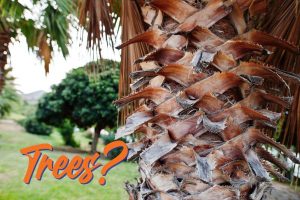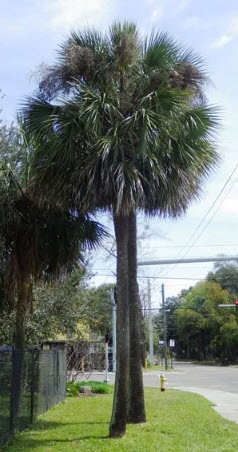 This post entertains an ongoing debate that I often hear: Are palm trees really trees? Could our state tree, the sable palm, not even be a tree?
This post entertains an ongoing debate that I often hear: Are palm trees really trees? Could our state tree, the sable palm, not even be a tree?
This has been argued in many different ways with the answer lying somewhere in the middle. Skip down to the end if you want to read what I think the answer is. However, keep reading if you want to learn why both sides have valid points.
You may wonder why this is even an argument. Palms grow tall, sometimes reaching 50-60 feet in height. If that is not a tree, then what is it?
Biologically Speaking
The root of the conflict is based in biology. Palms are very different anatomically than most trees in many ways. The first way they are different is in how they transport water and nutrients up and down from the roots to the canopy. In typical trees, you have this vascular tissue arranged in a very specific way. If you start from the bark and drill towards the middle of the tree you will encounter 4 distinct layers with the first three being very thin.
Tree Layers:
-
- Bark – which protects the tree.
- Phloem – very thin layer – that transports the sugars made in the leaves throughout the tree.
- The cambium, a ring only two cells thick, that is constantly producing more wood allowing the tree to continually grow in diameter.
- The xylem. The largest layer, the xylem transports water up the tree to the foliage. It’s where the annual rings are and is the part that gives the tree its strength.

Vascular System
The vascular system in palms is arranged very differently. If you have ever looked at a palm trunk cross-section, it is unique. First, palms don’t have bark. What appears to be bark is simply dried-out tissue left over after the fronds are shed. This is commonly called a pseudobark. Secondly, palms do not increase in diameter as they get older. This is because they do not have a cambium that increases the trunk diameter. Palms also don’t have layers of phloem and xylem with its annual rings. Instead, the xylem and phloem are arranged in bundles throughout the trunk. This is very similar to the strands in a celery stalk. In between the bundles is a very fibrous tissue that adds strength to the palm trunk allowing it to remain upright.
You may ask, “So what if palms grow differently from typical trees? They are still trees.” As I said in the beginning, the basis of the debate is in biology. Palms are part of a group of plants called monocots. Other monocots include corn, grasses, lilies, and onions. Typical trees belong to a group of plants called dicots. Most shrubs, vines and other woody plants are dicots.
Well, are palm trees really trees?
The folks that don’t see palms as trees (like me) simply argue that palms are closer to tall grasses than they are to trees. As time goes on, so does the debate.
If you would like to find more information on palms, go to edis.ifas.ufl.edu/topics/palms.
Larry Figart is an urban forestry extension agent with the University of Florida/IFAS.
More tips:What you should know about pruning trees and when to prune them
 8
8
